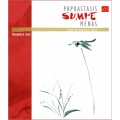 Original language:
English
Original language:
English Translated from: English
Authors: Takumasa Ono
Translated by: Tilindytė, Lina
Full translated source bibliographical description:
Takumasa Ono. The Simple Art of Sumi-E: Mastering Japanese Ink Painting. Sterling, 2005.
ISBN: 9781402720093
Published in: Vilnius
Published on: 2012
Publisher: Mintis
Link::
ISBN 9781402720093
Born in Tokyo in 1959 Takumasa Ono is a full time artist. Who has travelled to various regions of Japan and in support of enviromental protection activities, painted the nature of Japan, that he hopes will be left untouched. He also vigorously works to introduce traditional Japanese culture to foreign countries.
Author‘s book is a very detailed introduction to the japanese traditional brush painting – sumi-e.In it author writes that sumi-e is the ideal way to portray the environment and the seasons exactly as they are seen in their imagination. This type of art is better at expressing your mood and mystery of nature, rather than portraying objects as they are. Sumi-e uses only black ink, but that is not the most important aspect of it, this is a form of art that draws inspiration from typical seasonal and aesthetic changes that are characteristics of Japan and its people.
This book contains the history of sumi-e. Beginning with its start in ancient China around eight century. The author discusses the yearly period of this art form in Japan during the XII-XIII ages, when it is influenced by Zen Buddhism. Then, it moves on to the formation of Japanese sumi-e. Author in details specifies the stages of sumi-e development as an art form and how it changes during certain periods, also describing the most prominent sumi-e masters, texts about said masters are accompanied with images of their most famous works. A lot of attention is diverted towards different sensuality and ideas, rather than pure painting techniques.
After discussing the history of this art form, the author then focuses on “four treasures” – the main necessities when working with sumi-e: paper (washi), brush (Fude) Indian ink rub (Suzuran) and the reservoir plate (sumi). He also discusses several less significant things. Different types of paper that can be used when making sumi-e art, how to use it, when to use it, under what conditions to keep the paper, to keep it from harm, all of this and more is explained by the author. Everything is great detail and accompanied by useful pictures. Also, thoroughly described are brushes, along with instructions on how to deal with them. The world of sumi-e differentiates itself by having an abundance of black sumi ink and its nuance magnificence, on which its beauty is dependent. Two different types of ink slabs are presented, the author explains how they differentiate from the ones imported from China and how to use them.
The author then goes on to practical advices, how to get ready for work with sumi-e. In grave detail various techniques are explained, so is ink mixing, how to hold the brush and everything related to these things.
Sumi-e is the art of body and mind. While using only the sumi color and thrifty brushes with the brush, you convey the forms and tones of the picture. When sumi and paper joins, the possibility of redoing the painting becomes unavailable, because of that you have to put both your mind and soul into into the painting. Author specifies how to mix the color and draw the lines, everything is explained and shown in pictures: basic lines, wide and narrow lines and so on. Author shows and explains how to draw flowers, birds, animals and their composition, also, how to compose scenery.
Sumi-e for many ages was connected to Japanese culture and even with passage of time remains one of the most liked Japanese art forms. Author uses sumi-e to realise a lot of ideas and creates works of art, that can add brilliance to the home of the reader, since he gives examples on how to creat those said works of art at home. These works of art vary from small handmade post cards, pillows, to ware and so on, everything embroidered using sumi-e. At the end of the book author dedicates a little bit of time to inspire the reader and provides haga – haiku text painted in sumi-e style.
